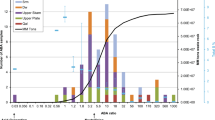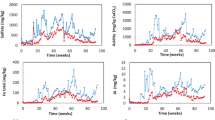Abstract
The Waste Isolation Pilot Plant (WIPP) is located at a depth of 655 m in bedded salt at a site about 40 km east of Carlsbad, New Mexico.The 1996 U. S. Department of Energy (DOE) application for certification by the U. S. Environmental Protection Agency (EPA) included results of a performance assessment (PA) for the planned repository.After the EPA certified the facility in May, 1998, emplacement of contact handled transuranic waste (CHTRU) began in March, 1999.The WIPP facility must undergo a recertification by EPA every 5 years to demonstrate compliance with disposal regulations.Performance assessment is expected to be a key part of the recertification process.The PA will include probabilistic calculations to predict the release of actinides to the accessible environment over a 10,000 year period using a variety of plausible scenarios.The 1996 PA used a model for Pu(IV) solubility based on Th data and the assumption of analogous behavior for all actinides in the (IV) oxidation state.That model did not allow for mobility between the various possible oxidation states of Pu.The possible effects of increases in solubility of Pu through complexation with organic ligands was also not included in the PA because it was argued by DOE that such complexation would be insignificant. Subsequent data from tests using actual TRU wastes show strong evidence that the importance of organic ligands and the potential for multiple oxidation states must be carefully considered in estimating the expected solution concentrations of Pu in WIPP brines.This paper reviews the present state of knowledge of the behavior of Pu-containing wastes in contact with brines similar to those expected to be important for the WIPP repository, recent advances in understanding of the nature of Pu-oxide phases, and analytical methods that have high sensitivity for Pu speciation. A conceptual model for Pu in TRU wastes is presented and a series of steps - including experiments and calculations - that could led to an improved basis for the PA calculations to be done during the WIPP recertification process is outlined.
Similar content being viewed by others
References
U. S. Environmental Protection Agency, Criteria for the Certification and Recertification of the Waste Isolation Pilot Plant’s Compliance With the Disposal Regulations:Certification Decision; Final Rule.Federal Register (May 18) vol. 63, no.95, pp. 27353–27406, 1998.
U. S. Environmental Protection Agency, Environmental Radiation Protection Standards for Management and Disposal of Spent Nuclear Fuel, High Level and Transuranic Radioactive Wastes.40 Code of Federal Regulations Part 191, 1993.
U. S. Environmental Protection Agency, Criteria for the Certification and Recertification of the Waste Isolation Pilot Plant’s Compliance with the 40CFR Part 191 Disposal Regulations; Final Rule. Federal Register (February 9) vol. 61, no. 28, pp. 5224–5245, 1996.
U. S. Department of Energy, Carlsbad Area Office, Title 40 CFR Part 191 Compliance Certification Application for the Waste Isolation Pilot Plant, Final.DOE/CAO-1996-2184 (21 vols.) 1996.
V. M. Oversby, Plutonium Chemistry under Conditions Relevant for WIPP Performance Assessment - Review of Experimental Results and Recommendations for Future Work, Environmental Evaluation Group Report EEG-77, Albuquerque, New Mexico, July 2000.
R. H. Neill, L. Chaturvedi, D. F. Rucker, M. K. Silva, B. A. Walker, J. K. Channell, and T. M. Clemo, Evaluation of the WIPP Project’s Compliance with the EPA Radiation Protection Standards for Disposal of Transuranic Waste, EEG-68, Environmental Evaluation Group, New Mexico, March 1998.
K. Ollila, Solubility of UO2 under anoxic conditions, Comparison between undersaturated and oversaturated experiments, presentation given at the Spent Fuel Workshop, Toronto, Canada, September 1999.
B. Grambow et al., Source term for performance assessment of spent fuel as a waste form, Final Report, European Commission Report EUR 19140 EN, 2000.
S. Röllin, On-line coupling of an ion chromatograph to the ICP-MS: Separations with a cation exchange chromatography column, SKB Technical Report 99-35, Stockholm, Sweden, December 1999.
J. M. Haschke, T. H. Allen, and L. A. Morales, Reaction of Plutonium Dioxide with Water: Formation and Properties of PuO2+x, Science 287, 285–287, 2000.
R. Villareal, Presentation of STTP results to EEG, Albuquerque, November 23, 1999.
U.S. Department of Energy, Final Environmental Impact Statement on Management of Certain Plutonium Residues and Scrub Alloy Stored at the Rocky Flats Environmental Technology Site.DOE/EIS. 0277F, August, 1998.
Author information
Authors and Affiliations
Rights and permissions
About this article
Cite this article
Silva, M.K., Oversby, V.M. Using Results from Tru Experiments for WIPP to Determine Model Development and Needed Experimental Programs. MRS Online Proceedings Library 663, 783 (2000). https://doi.org/10.1557/PROC-663-783
Published:
DOI: https://doi.org/10.1557/PROC-663-783




